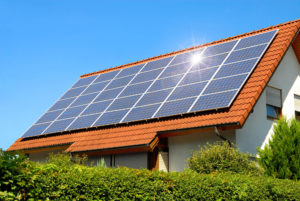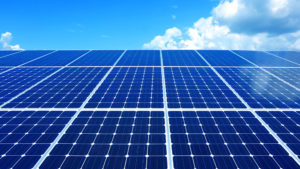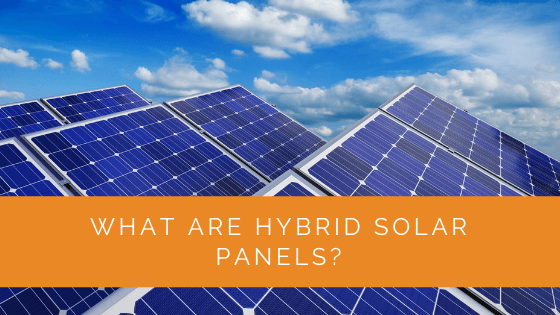While we know about solar panels and their types, the concept of hybrid solar panels remains a novelty to most. So, what are hybrid solar panels, and what sets them apart?
Hybrid solar panels are known by different names: mixed panels, hybrid solar systems, hybrid solar cells, etc. They are all terms referring to the same thing. To put it simply, in a hybrid solar system, you will find a combination of thermal (for heat production) and photovoltaic (for electricity generation) systems. Due to this combination, a hybrid solar system can make the most out of the sun’s energy.
Recently, GE Renewable Energy was in the news for its plan to build the largest hybrid solar storage system in New York.
This post will help you form a clear picture of hybrid solar systems: what they are, how they work, the different types, who can use them, their benefits, and so on. Please do ensure that you read our post till the end.
Contents
- 1 Key Takeaways
- 2 Hybrid Solar Systems: Explained
- 3 How Do Hybrid Solar Systems Work?
- 4 The Different Types of a Hybrid Solar Panel
- 5 Who Can Use Hybrid Solar Panels?
- 6 What are the Benefits of Hybrid Solar Panels?
- 7 What Are the Disadvantages of Hybrid Solar Systems?
- 8 Experience Solar Excellence with Us!
- 9 Wrapping Up
Key Takeaways
- Hybrid solar panels combine thermal and photovoltaic technologies, making them highly efficient in harnessing solar energy.
- Hybrid solar systems can store excess energy in batteries, providing continuous and backup power, unlike traditional grid solar systems.
- These systems have various applications, including residential buildings, hotels, hospitals, and commercial complexes, offering benefits such as continuous power supply, resource efficiency, and low maintenance costs, but they can be costly to install.
Hybrid Solar Systems: Explained
In a hybrid solar panel, two leading technologies operate, thermal technology and photovoltaic technology. Traditionally, thermal solar panels and photovoltaic solar panels used to be stand-alone, separate entities. Combining the two panels in hybrid solar systems made it possible to create a single, hybrid, and highly efficient model.
 Given its hybrid nature, a hybrid solar panel can absorb both ultraviolet and infrared rays of sunlight. Therefore, the panel can put the sun’s energy to the best possible use. Usually, the power generation mechanism of hybrid solar systems is the same as the one in common grid solar systems. However, there is one key difference.
Given its hybrid nature, a hybrid solar panel can absorb both ultraviolet and infrared rays of sunlight. Therefore, the panel can put the sun’s energy to the best possible use. Usually, the power generation mechanism of hybrid solar systems is the same as the one in common grid solar systems. However, there is one key difference.
At times, a hybrid solar panel can use hybrid batteries to store the energy generated for later use – something that grid solar systems are incapable of doing. The combination of energy storage with electricity generation is a huge advantage. Why, you ask?
Here’s why: when you use a standalone thermal or photovoltaic solar system, you cannot make use of any excess electricity that might have been generated during the day. And, in the absence of a storage system, you’ll find yourself needing to find alternative sources of energy to meet your electricity needs during the latter half of the day.
However, that’s not the case with a hybrid solar panel. The system comes with a hybrid inverter or a set of batteries that you can use to store the excess energy. Consequently, the hybrid solar panel has sufficient energy to meet your round-the-clock electricity requirements.
In the case of a power outage or shutdown in your area, the hybrid solar panel can use the stored energy to double up as a source of backup power as well.
How Do Hybrid Solar Systems Work?
Before looking into the working mechanism of a hybrid solar system, consider the three major parts involved: solar panels, a solar hybrid inverter, a battery storage system, and a smart meter. Here’s how these parts interact to make the hybrid system work:
- First, the solar energy captured by the solar panels is sent to the solar inverter in the solar hybrid system.
- The hybrid inverter converts solar energy into a useable form of electricity and supplies that to your household.
- If there is surplus energy, the hybrid inverter sends it to the battery for storage.
- You can use this stored solar energy to meet your electricity needs during the night or as a backup power source in the event of a local blackout.
- If you choose not to use the excess energy, the hybrid inverter will send the energy to the electric grid systems via the smart meter.
When it comes to a hybrid solar system, one question gets frequently asked: Which battery should I choose to power the storage system? In 2021, three popular batteries have emerged:
Tesla Powerwall
The Tesla Powerwall batteries have always been the go-to choice for hybrid solar systems. And, given the benefits, it comes as little surprise. The batteries come with a storage capacity of 14 kW and are designed to utilize the stored energy to the fullest. Moreover, the batteries are truly long-lasting. As of 2021, the Tesla Powerwall 2 is the one ruling the roost in the market.
Sungrow SBP4K8
The Sungrow SBP4K8 batteries are from Samsung. They are powered by the Samsung Lithium NMC cells. They have a size of 4.8 kWh and can provide 2.5 kW of continuous power, with a maximum peak of 4 kW. Their cycle life is pegged at an impressive 6000 cycles.
LG Chem RESU 10
These batteries from LG operate on the DC battery system with Lithium NMC pouch cells. Although their size is 9.8 kWh, you can expand it up to 19.6 kWh. The batteries have a continuous power output of 5 kW, reaching 7 kW at the peak. The LG Chem RESU 10’s cycle life stands at 4000 cycles.
The Different Types of a Hybrid Solar Panel
Over the years, the hybrid solar system has evolved into different types. This section will walk you through the most common types of hybrid systems. They have been classified according to generations. See for yourself:
0 Generation Hybrid Solar System
As it is the earliest known hybrid system model, everything about this type is simple and rudimentary. It consists of just three parts: a bunch of photovoltaic cells, a heat absorber, and a junction box.
The simplicity means that this hybrid solar system cannot reach very high temperatures, reducing its ability to provide solar power. You’ll find this solar system is used in places and applications that require lower temperatures.
For instance, considering that swimming pools don’t require very warm water, the 0 Generation Hybrid System is used.
First Generation Hybrid Solar System
 Also known as PVT-1, these hybrid systems are incorporated with features that considerably improve the previous type. Here, the junction box is covered with a rear cover to prevent unnecessary loss of thermal energy. Moreover, the electrical part of the panel is slightly more enhanced.
Also known as PVT-1, these hybrid systems are incorporated with features that considerably improve the previous type. Here, the junction box is covered with a rear cover to prevent unnecessary loss of thermal energy. Moreover, the electrical part of the panel is slightly more enhanced.
Here’s a fact: The First Generation Hybrid Solar Systems are the most popular hybrid systems worldwide. This type of solar hybrid system works the best when installed in places characterized by high temperatures and plenty of sunshine.
Second Generation Hybrid Solar System
The PVT-2 is very similar to the PVT-1, except it also comes with a transparent front cover. This feature is essential to prevent the loss of thermal energy from the front. By isolating the panel on both fronts, the PVT-2 can provide high-efficiency energy management.
Considering that these hybrid systems are big on thermal properties, they are ideal for solar installation where the temperature tends to be low throughout the year.
Who Can Use Hybrid Solar Panels?
 When it comes to the installation of hybrid solar panels, one factor becomes important: the surface area for solar installation needs to be small. Additionally, it has been found that hybrid systems are ideal for establishments that rely on solar power to meet their domestic hot water needs.
When it comes to the installation of hybrid solar panels, one factor becomes important: the surface area for solar installation needs to be small. Additionally, it has been found that hybrid systems are ideal for establishments that rely on solar power to meet their domestic hot water needs.
Therefore, hybrid solar panels can be used by:
- Hotels and other hospitality establishments.
- Residential buildings, colonies, and gated communities.
- Hospitals and healthcare establishments.
- Car wash companies
- Thermal power industries
- Offices
- Schools, Colleges and Universities
- Commercial Complexes
You can consider installing hybrid systems even if you own an independent house, provided you can find the surface area required.
What are the Benefits of Hybrid Solar Panels?
There are many advantages of hybrid solar energy systems. A few of them are listed below:
Continuous Solar Power Supply
As mentioned earlier, the battery storage element of hybrid solar panels ensures that they can provide a continuous power supply. Further, they can provide a backup power supply as well, should you need it.
Resourceful
Hybrid solar panels can capture the ultraviolet and infrared energy of the sun, utilizing solar energy to the fullest. Further, the surplus energy generated is usually stored or sent back to the electric grid systems, ensuring zero wastage of valuable renewable energy.
Low Maintenance Costs
Research has shown that when compared with diesel generators and other modes of electricity generation, hybrid solar systems incur low maintenance costs, as no fuel is required to power them.
Efficiency
Hybrid solar panels can perform with high efficiency while ensuring minimal wastage of energy and other resources. They require less surface area for solar installation, so hybrid solar systems are area efficient too.
Energy-efficient? Check. Maintenance-efficient? Check. Resource-efficient? Check.
Phased Power Supply
Hybrid solar systems can adjust the power supply according to the energy requirements of each appliance. This gives them an advantage over other traditional modes of electricity supply, like diesel generators.
What Are the Disadvantages of Hybrid Solar Systems?
Hybrid solar systems have certain disadvantages associated with them. They are listed below:
- High cost of installation: Despite the low cost of maintenance, the cost of installing a hybrid solar system remains high.
- Limitation on the number of devices that can be connected: Unlike grid solar systems, hybrid solar systems do not allow you to connect many devices.
- Low battery life: After installing them, you can expect your hybrid solar system to last for anywhere between 7-15 years. Compared to the grid solar power systems this is quite less.
Experience Solar Excellence with Us!
Trust in Solar Panels Network USA, where our seasoned experts deliver top-quality solar solutions for homes and businesses nationwide. With a legacy of countless successful installations and a commitment to sustainable energy, we’re your reliable partner in the solar journey. Ready for a brighter, eco-friendly future? Call us now at (855) 427-0058 and harness the power of the sun!
Wrapping Up
This post was all about what are hybrid solar systems. The introduction gave you a brief overview of hybrid solar panels and what you could expect from this post. We followed it up with a detailed explanation about the various aspects concerning hybrid solar energy systems and technologies. We also briefly touched upon solar energy management.
Additionally, we covered the working principle of hybrid solar panels. We also told you about the best batteries you can use in the hybrid battery storage system. The different types of hybrid solar energy systems, and their specifications, were also dealt with.
Finally, we provided a comprehensive analysis of the advantages and disadvantages of hybrid solar energy systems.
We hope that this post was instrumental in getting you acquainted with hybrid solar systems. Feel free to reach out to us to learn more!
About the Author
Solar Panels Network USA stands at the forefront of solar energy solutions, driven by a team of seasoned solar engineers and energy consultants. With over decades of experience in delivering high-quality solar installations and maintenance, we are committed to promoting sustainable energy through customer-centric, tailored solutions. Our articles reflect this commitment, crafted collaboratively by experts to provide accurate, up-to-date insights into solar technology, ensuring our readers are well-informed and empowered in their solar energy decisions.

